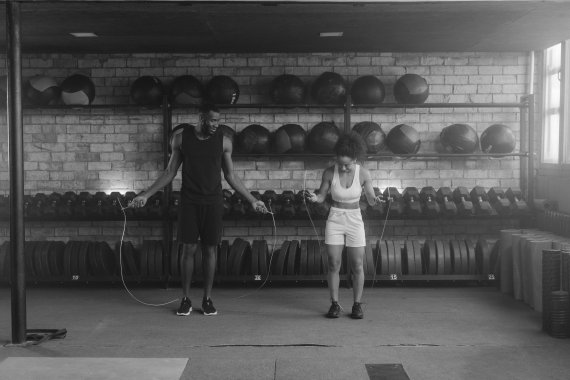When jumping rope, the whole body is challenged. Countless muscle groups are trained, especially legs, abdomen, arms, chest and shoulders. In addition, the speed and bounce improves fitness and strengthens the cardiovascular system.
If you want to increase your fitness, you can do well with just ten minutes of rope skipping a day. Beginners should start with one minute of rope skipping and one minute of rest in alternation. The condition increases noticeably after a few days and ten minutes of rope skipping at a time are no problem, I promise!
Rope skipping burns a total of 150 calories in ten minutes. That makes up to 500 calories per half hour. Jogging burns about 350 calories in the same amount of time.
There are many different jumping techniques that make training with the rope more varied. From simple jumping on the spot, to one-legged jumps, so-called jumping jacks, where the feet are alternately opened sideways during the jump, like a jumping jack, double rope swings or rope jumping with crossed arms, the training session can be varied at will.
Because rope skipping requires concentration, coordination and a sense of rhythm, it's not just the body that's called upon, but also the mind. The positive effect on mental fitness is further enhanced when the step and jump sequences vary during each training session.

Who also thinks of light-footed boxers before competition when they think of rope skipping? This is no coincidence, because rope skipping is an efficient and quick warm-up before martial arts or weight training. Due to the fast movement sequences, the body is already warmed up in ten minutes.
Last but not least, the trend around rope skipping is booming because it's super easy to get started and doesn't require much more than a suitable rope. Whether indoors or outdoors - with enough space to the front, back and top, the fitness trend can be practiced almost anywhere. The positive memory of childhood days also ensures a high fun factor - similar to the hula hoop.

To avoid risks such as joint or cartilage damage, here are a few more important tips to keep in mind when jumping rope:
- Proper footwear: Ankles and tendons are best protected in sturdy shoes with forefoot cushioning and a high upper.
- The right surface: Jumps are cushioned on a carpet, grass or soft indoor floor. This is easy on the joints. Never jump on asphalt!
- The right rope: The general measurement for the right length is body height plus 91.5 cm. The best way to test the length is to stand in the middle of the rope. The ends of the rope should reach chest height. For beginners:inside there are jump ropes made of plastic, for professionals some made of steel, brass or leather and with integrated weights.
The right technique: Warm up before the workout by circling arms, hands and feet and going up on your toes a few times, then slowly lowering your feet. Swing the rope from the wrists, keeping the arms close to the body. As you jump, keep your legs bent and land lightly.
- ISPO awards
- Mountain sports
- Bike
- Design
- Retail
- Fitness
- Health
- ISPO Job Market
- ISPO Munich
- ISPO Shanghai
- Running
- Brands
- Sustainability
- Olympia
- OutDoor
- Promotion
- Sports Business
- ISPO Textrends
- Triathlon
- Water sports
- Winter sports
- eSports
- SportsTech
- OutDoor by ISPO
- Heroes
- Transformation
- Sport Fashion
- Urban Culture
- Challenges of a CEO
- Trade fairs
- Sports
- Find the Balance
- Product reviews
- Newsletter Exclusive Area
- Magazine







